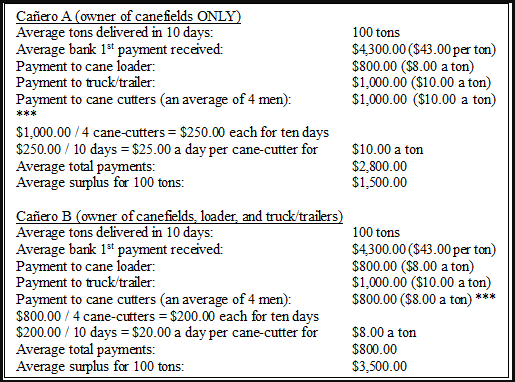“No matter who or what you support, I believe in supporting fairness first.”
– Jennette McCurdy
Dear Editor,
The escalating tension here in the North is indeed a very crippling experience that continues to dampen and even dismantle the spirits of many families, particularly those whose livelihoods are anchored in the squealing axis of the sugar industry itself.
As a canefarmer, I indeed stand in full support and solidarity with my compañeros cañeros in a most unconditional and steadfast manner as we hope that whatever differences between our representative, the BSCFA, and BSI/ASR are well-ironed out in a meticulous way that will seek to always protect and promote our interests in this very important industry.
As much as I will ever support my comrades in this social fight for survival, however, I also seek to underscore that our cane-cutters, who sit at the bottom steps of the ladder, are being forgotten, inadvertently or not, year after year. As the norm embraced by many cane farmers, and especially those who not only own numerous acres of cane-fields but also are owners of harvesting equipment (cane loader and trucks and/or tractor with trailers), cane-cutters are generally paid $8.00 a ton for the sugarcane they cut, with no other direct or indirect benefits that can possibly trickle down from any by-products from the sugarcane (such as bagasse) or from any agreements such as Fair Trade agreements with the BSCFA, for example.
It is these very same cane-cutters who, drenched in both sweat and morning mist, meet the dawn of the day in the cane fields, in fervent hope that a fair day’s pay is achieved before the scorching sun continues to reprimand their noble efforts. It is these same cane-cutters who ensure that fresh, clean, and quality sugar cane remains a priority in the delivery of the same. With no days-off, severance pay, or vacation pay, coupled with the exposure to the vagaries of the climate and other physical threats such as rodent and snake bites, these cane-cutters will always remain indispensably essential in this invisible sugar-sweet chain.
But, is $8.00 a ton paid to our cane-cutters fair enough? Why not at least $10.00 a ton?

Let us study this hypothetical example:
For Cañero A, with everything else held constant, he remains with a surplus of $1,300.00 in a ten-day period for a 100-tons delivery, income that will certainly be partially re-directed to the 3-4 acres of cane field that harvested said 100 tons, similarly to Cañero B who has in his pockets far more surplus than his counterpart who does not own any equipment (loader and/or truck). I reiterate that this is taking into consideration that an average of ONE 10-ton trip is delivered on a daily basis by 4 cane-cutters on both scenarios. Most certainly, there can be instances where more than 4 cane-cutters are employed by any cane farmer.
For Cañero B, who owns both the cane field and equipment, payment for loader and truck operators/drivers in the $1,800.00 is already included. It is important to highlight that Cañero A is paying his cane-cutters $2.00 more than Cañero B despite only owning the sugar cane but no equipment. The payment of $10.00 a ton to cane-cutters by a cane farmer who does not own any equipment is NOT always the case, however, as some tend to also pay $8.00 a ton.
Similarly, more than one ten-ton trip can be possibly delivered in any day depending on the tonnage allowed for each reaping group or individual cane farmer not in a reaping group. In both scenarios, furthermore, economies of scale will always kick-in since it will eventually cost less to harvest more.
Of important note also, the $43.00 paid by the bank is an average payment for the first payment only; cane farmers continue to get 2nd and 3rd payments a month after the sugar crop closes and in early December respectively. Both payments vary nonetheless amongst reaping groups since it is dependent on the quality of sugar delivered during the sugar season by such groups. Income derived from both 2nd and 3rd payments are once again partially re-invested in the fields with no payments whatsoever for harvesting and delivery equipment such as the loader and truck/tractor with trailers.
So then, if Cañero A, who does not own any equipment, can afford to pay cane-cutters $10.00 a ton and still juggle around with his daily expenses and obligations quite efficiently, why not a cane farmer with greater cane ownership including equipment such as loader and truck/tractor with trailers, be generous enough to pay his cane-cutters at least $10.00 a ton? Perhaps standardizing the minimum payment for cañeros is a great idea that will not only add economic relief to the cane-cutter but also spread social equilibrium on this side of the playing field. I am sure that on this side my colleague cane farmers with enviable assets such as loaders and trucks/tractors and with sugar delivery licenses of more than five hundred and even a thousand tons will understand the cane cutters’ plight.
As a teacher and a cane farmer, I go for fairness; this value means a lot to me and has convinced me to continue paying my cane cutters $11.00 a ton.
But again, $25.00 and $20.00 a day respectively for cane-cutters in both scenarios continues to be a pittance in every sense of the word.
¡El cortador de caña merece más!
Respectfully,
(Signed ) Germán Tzul
Teacher/Cane farmer


